By Steven Smith
This training session emphasizes small group play and defending the vital zone with crossed balls. Finishing activities designed to give repetition will also be a focus.
Lesson 1: Brazilian Warm-up
Setup:
Three to four sets of the triangles are set up as shown in the first diagram. Three players are in each triangle and set up on the cone in each location. Distance between cones should be about five yards within the triangle and 15 yards between triangle sets.
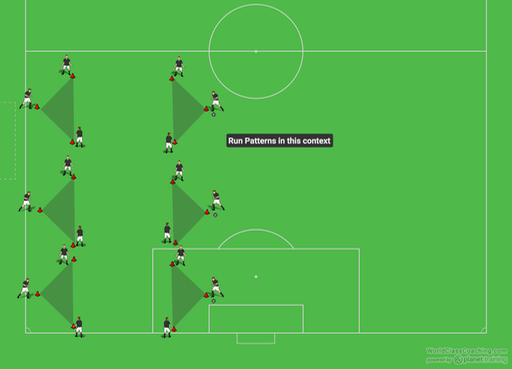
Execution:
Players execute a series of predetermined passing sequences as shown in each diagram. Players should eventually become so adept at this warm up that it can be led by the players with the switching of the patterns being done by the leaders of your group. Spend approximately three minutes on each passing sequence before switching sides.
Variations:
1. Coach can set up competitions between the groups to see how many passes in a pattern can be accomplished in a set amount of time.
2. Coach can change up the size of the triangles in increasingly bigger distances and switch groups to each of the increasingly bigger spaces. The precision of passing touches can be translated to the larger spaces that may occur in the game.
Coach this instead of just letting it happen. Demand their best communication and touch. No neutral training.
Lesson 2: Main Series: Endless Transition 4 v 4
Setup:
Flat four defense is set up in a functional setting about 10 yards in front of the 18 box. The attackers come in a group of four from the midfield stripe and counter attack goals are also set on the midfield stripe.
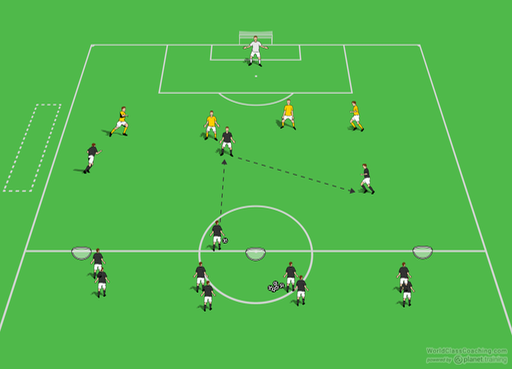
Execution:
Play is started by the four attackers coming from the midfield stripe. Instead of coming as a wave, a forward number nine player should settle in to the flat four line. Wing players can adjust their depth on each attack. If the attacking players are able to attain a shot on goal they gain one point and become the defenders. If they score they gain three points and get to become the defenders. If they turn over the ball to the defenders and the defenders score, the defenders gain three points and get to stay another round. Keep a strict score by group and reward the winners at the end.
Lesson 3: Passing and possession game 6v6
Main phase
Setup: 30 by 35 yard grids with two end zones with target players in each zone as shown.
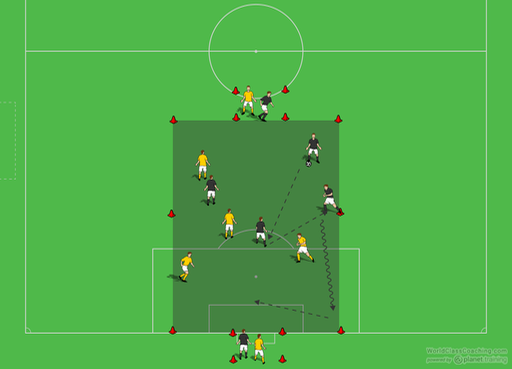
Execution:
Emphasis is on possession in the middle grid and then finding targets on either end. While maintaining possession in the middle portion a player attempts to find the target player in either end zone with a pass. The receiving player in the end zone then dribbles into the middle portion and the passer replaces the end zone player.
Variations:
Players in the end zone are unopposed.
Players in the end zone have defensive pressure from the opposing end zone player.
Lesson 4: Crossing Free Zones
Main phase
Setup:
Two free zones are set up outside a 36 by 30 yard field. Zones are free from defenders. Grid size can be up to half field depending on age of players and functional desire of coach. The free zone sizes can also be adjusted.
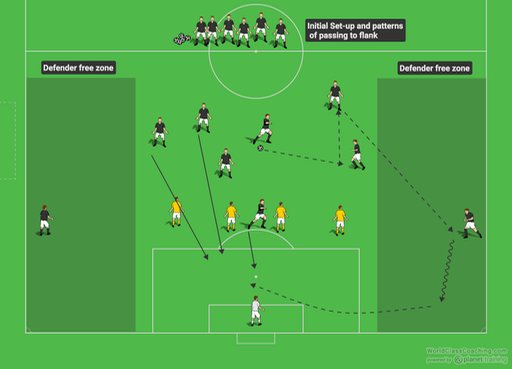
Execution:
Flat back four defend groups of attackers who come from end line with the ball. They can attack in combination play up the center of the field or they can send the ball to the flank zone that is free of defenders. Ball is crossed quickly and attackers attempt to score. When ball is cleared a new group of attackers come at the same defenders. Attack in groups of 6 plus free zone attackers.
Variations:
Coach can limit the attacking group to four players plus the flank free zone players.
Coach can require all attack to come from flank with all attackers selling out to the crossed ball without any balance.
Coach can blow whistle and the ball must get to the flank within two touches.
Coach can allow counter attack opportunity for the defending group on opposite full size goal.
Coach can limit the number of attackers that can come into the box for the crossed ball.
Lesson 5: Full sided play
Setup:
Groups of 11 vs. 11
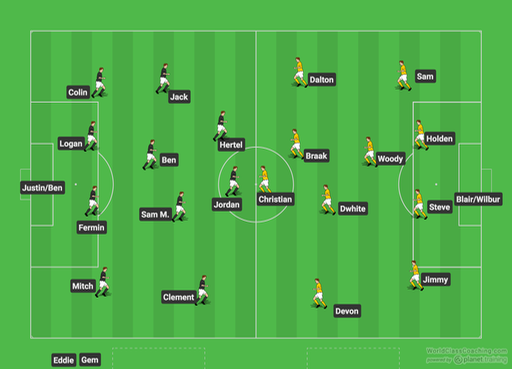
Execution:
Full field. Coaches randomly end play with whistle and start a new ball where the coach desires to work on functional play.
By Steven Smith Head Coach at Hope College, Holland, MI


